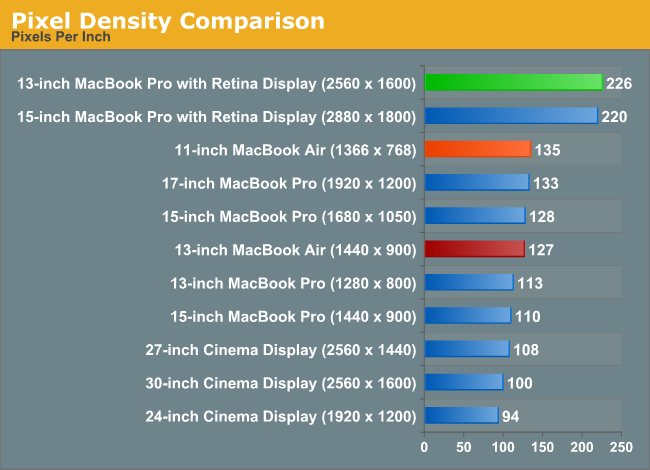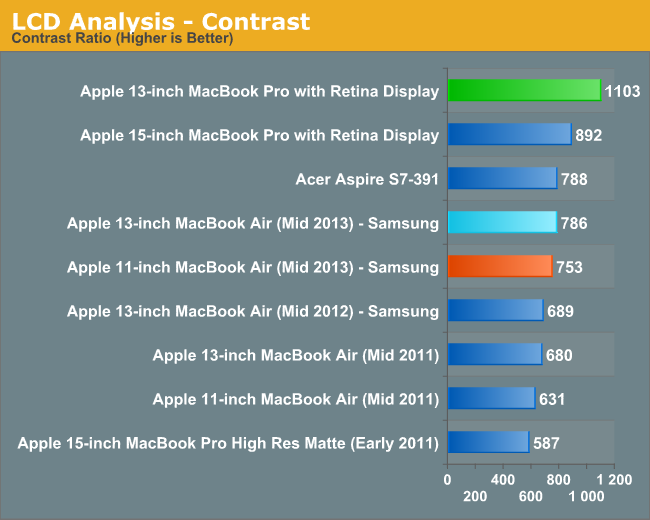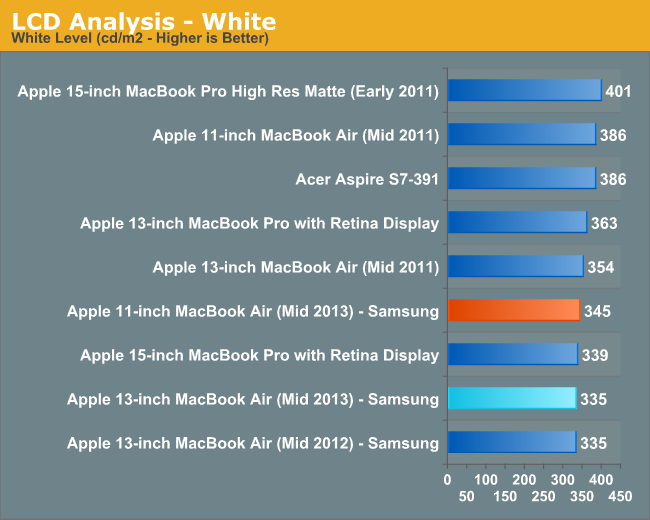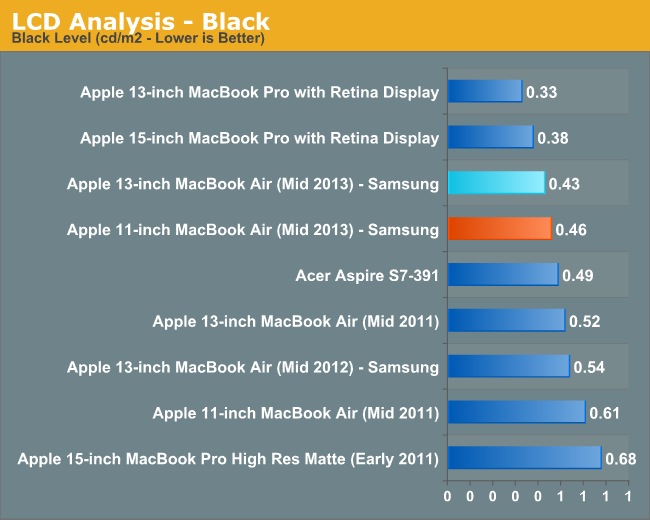The 2013 MacBook Air Review (11-inch)
by Vivek Gowri on August 9, 2013 1:45 AM ESTThe 11.6” Samsung display panel in my Air evaluation unit is actually the same one I had on my last MacBook Air, though the one before that had an LG panel. This is all based on the panel supply lottery, and while it’s been alleged that the Samsung is a superior quality panel in terms of contrast and viewing angles, I honestly can’t say there’s too much of a difference overall between the two. I’ve never had them side-by-side, and color calibration can certainly skew visual perception significantly, so let’s just say that your mileage may vary. If you don’t like the panel you get, take it back and try another one—Apple Stores seem to cater to discerning customers (or they have with me).
 Obviously, given our familiarity with the Air 11”, there’s nothing surprising here with the 2013 edition. It’s roughly the same as the last few we’ve had, beyond standard panel to panel variations. Contrast ratio and color reproduction are pretty decent, as they were before, and viewing angles are solid by the standards of TN panels. This is still the best 11.6” TN panel I think I’ve come across, but it’s been eclipsed many times over by the 1080p IPS 11.6” panels that are shipping in basically any higher-end 11.6” Ultrabook these days.
Obviously, given our familiarity with the Air 11”, there’s nothing surprising here with the 2013 edition. It’s roughly the same as the last few we’ve had, beyond standard panel to panel variations. Contrast ratio and color reproduction are pretty decent, as they were before, and viewing angles are solid by the standards of TN panels. This is still the best 11.6” TN panel I think I’ve come across, but it’s been eclipsed many times over by the 1080p IPS 11.6” panels that are shipping in basically any higher-end 11.6” Ultrabook these days.


 This is probably the biggest issue that I have with the 11” Air. The 11.6” 1366x768 TN panel was industry standard when the first Air 11” hit the market, and the panel quality was actually pretty decent. The display size, pixel density, and aspect ratio each specifically aren’t bad on their own, but the combination results in a pretty unsatisfying viewing experience in this day and age. I’ve never liked the 1366x768 resolution for notebook displays, regardless of panel size; the lack of vertical pixels just kills it for me. Even 1280x800 in the 13” MacBook Pro (non-Retina) is better. I don’t mind 16:9 as an aspect ratio, even at this size, but I just want more pixels. That’s really the biggest part of what makes the 13” so much more usable, the 1440x900 display in that also won’t blow you away in terms of dot pitch or even visually when compared to the Retina MacBook Pro or a modern Ultrabook, but it offers a much more pleasant experience than this 11.6” panel.
This is probably the biggest issue that I have with the 11” Air. The 11.6” 1366x768 TN panel was industry standard when the first Air 11” hit the market, and the panel quality was actually pretty decent. The display size, pixel density, and aspect ratio each specifically aren’t bad on their own, but the combination results in a pretty unsatisfying viewing experience in this day and age. I’ve never liked the 1366x768 resolution for notebook displays, regardless of panel size; the lack of vertical pixels just kills it for me. Even 1280x800 in the 13” MacBook Pro (non-Retina) is better. I don’t mind 16:9 as an aspect ratio, even at this size, but I just want more pixels. That’s really the biggest part of what makes the 13” so much more usable, the 1440x900 display in that also won’t blow you away in terms of dot pitch or even visually when compared to the Retina MacBook Pro or a modern Ultrabook, but it offers a much more pleasant experience than this 11.6” panel.










139 Comments
View All Comments
DigitalFreak - Friday, August 9, 2013 - link
"Higher screen res typically comes at the expense of poorer battery life. Apple simply made a judgement call to prioritize PROFIT over everything else. I don't see that as an inherently bad thing."solipsism - Friday, August 9, 2013 - link
And yet they've been pioneers to add high-density displays to nearly their entire line when most people on this site were saying how pointless it was. It's apparently more difficult than you give it credit or the Samsung Ativ Book 9 wouldn't be considerably higher priced than a comparably specced MBP.DesktopMan - Saturday, August 10, 2013 - link
Displays aren't actually very expensive. Look up retina screens on eBay. Samsung is charging that because they think they can, not because they have to. IMO the Ativ Book 9 is priced too high for success.ananduser - Saturday, August 10, 2013 - link
Cut the crap with the "pioneering" please. They only provided the first leak of a pissing contest in display panels. Sony's quantum dot tech present on their Vaios is pioneering, the iphone was pioneering; paying Samsung/LG to provide you high res panels is NOT pioneering.solipsism - Saturday, August 10, 2013 - link
Sure it is. Investing in a technology that a vendor saw no route for monotizing is moving technology forward. History has shown that it's not enough to simply have created a technology but you need to have an application that can effectively utilize it. Just within the the recent years of Apple we've seen Intel dust off their SFF ULVs to make them the basis of an entirely new Ultrabook™ brand under Intel, we've seen Corning retrofit a factory to make alkali-aluminosilicate sheet for the original iPhone that they then branded as Gorilla Glass® despite their CEO reportedly telling Steve Jobs it could not be done, we've seen Apple become in the most profitable handset vendor in the world in a little over a year of reaching the market despite claims from Blackberry (nee Research In Motion) that the iPhone OS couldn't be that smooth as well as the entire industry moving to a multi-touch capacitance touchscreen.What's amazing is that you could claim that none of those involve new ideas or methods which means that even Google hasn't pioneered search, email, other web-based apps, and ad placements simply because they all existed in some rudimentary and less useful ways prior to Google's involvement.
ananduser - Saturday, August 10, 2013 - link
You went way overboard. I did credit the iphone. There is nothing pioneering in being the first to fit a high res display in a laptop or a high res display in a smartphone(Sony and Sharp). It's like being the first to make a carbon fiber laptop, it's not pioneering.solipsism - Saturday, August 10, 2013 - link
Yes, it is pioneering to be able to source components (which you often invest heavily in years prior) that you then mass produce before anyone else. You can claim all you want that Sony demoed or shipped a smartphone in Japan with more pixels or a higher PPI at CES before Apple released the iPhone but that isn't exactly pioneering in the way Apple has. You clearly think that being "First!" is somehow more relevant than being feasibly priced, efficiently produced, of high quality, or mass marketed. You really need to look at the big picture of what is involved from the start to getting into the hands of consumers.fluxtatic - Sunday, August 11, 2013 - link
Pointlessly, it seems - 8 -> 11 hours makes a lot less impact than 5 -> 8 hours. There's no way in hell I'd pay over $1k for a laptop with a 1366x768 TN display. There's no excuse for that.KPOM - Friday, August 9, 2013 - link
I've long been a fan of the 11" MacBook Air, but after having used a 13" rMBP for the past few months I likely won't go back to the Air until it gets a Retina display. Hopefully that comes in 2014. Since OS X doesn't scale as well as Windows 8, we won't get a 1080p "compromise." It will either be 1366x768 or 2732x1536 next year.I prefer the form factor of the 11". The 13" rMBP weighs over 50% more, and it doesn't fit into iPad pockets or front pockets of briefcases/notebook cases the way the 11" Air does. I've heard rumors that the 13" rMBP will be made a bit thinner, but maybe what that means is that in 2014 the 13" Air and rMBP lines are merged. We'll get a better sense of Apple's direction when they release the Haswell rMBPs this fall.
wendoman - Friday, August 9, 2013 - link
> iPad versus MacBook Air 11” But which would I actually take?Surface Pro 2 with Haswell.